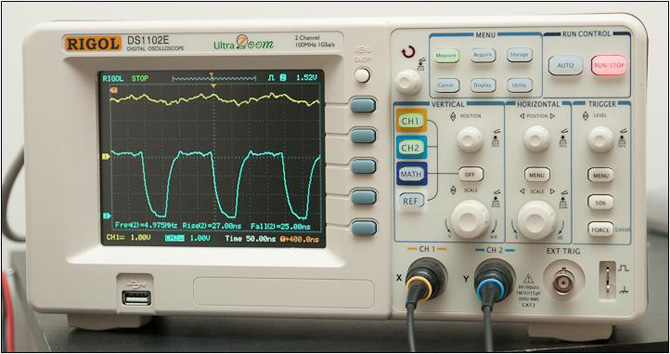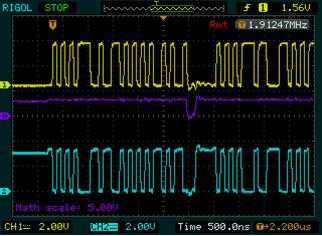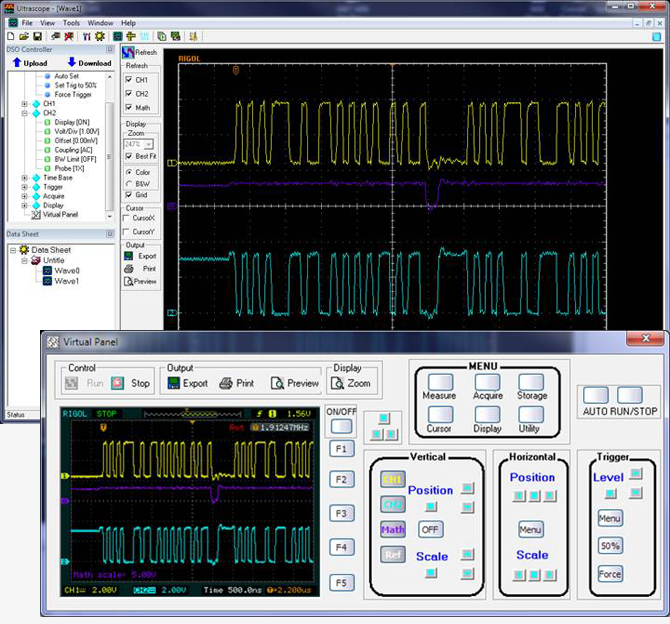Rigol DS1000 Series Oscilloscope
![]()
![]()
![]() The Rigol DS1000 series is a hi-tech digital oscilloscope with an exceptional set of features at a price that a hobbyist can afford.
The Rigol DS1000 series is a hi-tech digital oscilloscope with an exceptional set of features at a price that a hobbyist can afford.
I bought a DS1102E (the 100MHz version) new on EBay for US$657. The 50MHz version can be found for about US$150 less. This is amazing value for a digital storage oscilloscope with these specifications, it is encroaching onto the territory owned by Tektronix and Agilent... and their 100MHz oscilloscopes start at around $2000.
I have not used it for long, so this is more of a first impression rather than an in depth review but hopefully it will prove useful. And, how does it fare? Very good… It has a couple of annoyances but it is a joy to use a powerful instrument that you can trust.
Rigol is a Chinese electronics instrument manufacturer who has been around for only a few years. They make some of the low end oscilloscopes for Agilent (see here for the proof) and I can understand why that is so. The oscilloscope feels like an expensive instrument from a top rank manufacturer, not a cheap product from a low cost Asian producer.
The instrument itself is quite small, about the size of a small shoebox. In the past analogue 100MHz oscilloscopes needed a floor mounted trolley to carry them and here is something that would actually fit inside a shoebox. Inside the DS1102E it is mostly empty space with the switched mode power supply taking up more space than everything else.
The build quality is good, the buttons and knobs are slick and, for the most part, everything works perfectly.
Specifications
The specifications for the DS1000 series are included in the user manual which you can download from the Rigol website here. Rather than repeat the specs and the operating details I will keep this discussion to the points not covered in the documentation. However, just to get started, the key features of the instrument are:
- Two channels plus an external trigger input.
- 50 or 100MHz bandwidth, 1G samples/s and 1M samples memory depth (not both at the same time).
- 5.7 inch (diagonal) colour TFT LCD screen with a resolution of 240 x 320 pixels.
- A wide range of measurements including voltages, rise/fall times, period, frequency, pulse width, FFT, etc.
- USB socket on the front for saving data and images, USB and RS232 sockets on the back to connect to your computer for remote control (ie, like a USB based instrument).
 Display and Triggering
Display and Triggering
The stability of the trace is excellent. The displayed trace is rock solid and clear right up to the DS1102E’s maximum horizontal sweep of 2 ns/div. At the maximum sensitivity of 2 mV/div there is about 0.5mV of noise at the input which is not bad. There is also a jitter in the least significant bit of the ADCs that is present at all sensitivities and sweep speeds but again it is small and not a great concern.
Triggering is solid and very precise. Because this is a digital oscilloscope it will display a dotted horizontal line illustrating the trigger level as you adjust it and this makes it easy to see exactly at what point of the waveform you are triggering on. The options in this department are extensive to say the least - you can trigger on the normal rising and falling edge of a signal but also on various rise times, pulse widths, video characteristics and more.
Useability
The DS1000E series is certainly easy to use, the knobs and buttons do what you would expect and you can quickly focus on the detail that you are looking for. This is quite an achievement for an instrument with a lot of capabilities and a limited set of front panel controls.
Rigol mostly manages to do this trick by the extensive use of a menu system that pops up on the right hand side of the screen (as do most digital scopes). Options in the menu are selected by pressing one of the vertical row of soft buttons on the right of the screen. Mostly the menus and the options are easy to understand but some selections invoke a second menu layer and that can get confusing.
 When displayed the menus cover quite a lot of the screen real estate so I find that I am forever pressing the Menu Off button to see the full screen again.
When displayed the menus cover quite a lot of the screen real estate so I find that I am forever pressing the Menu Off button to see the full screen again.
The options selected by the menu system are endless. They range from obvious selections such as AC/DC coupling and probe attenuation (x1, x10, etc) through to a multitude of triggering and display options. All these settings are saved and recalled when you turn the instrument on again.
An issue that the early digital oscilloscopes seemed to have was a delay between turning a knob or pressing a button and the instrument responding. I am happy to say that the Rigol has none of that, the response is visually instantaneous.
About the only issue in the usability department is the fact that only one set of vertical adjustment knobs (sensitivity and position) are available for both channels 1 and 2. This means that you must select the channel before you can adjust its sensitivity or position on the screen.
Theoretically you can see what channel is currently associated to the knobs by checking the icons on the bottom of the screen but it would have been much better if the appropriate channel select button was illuminated with a different colour. As it is, rather than figure out what channel is currently under control, I just push the button for the channel that I want and then adjust the knobs.
This causes another usability issue in that these same channel select buttons are also used to display the menu for the channel or cause the channel to be tuned off. I haven't quite figured out the sequence yet so when I press a button to select a channel for adjustment I sometimes find that the menu has popped up or worse, the channel has disappeared altogether. This is not as bad as it sounds as repeated pressing of the button will get me back to where I want to be but it could have been designed much better.
The Fan
While on the subject of annoyances I must mention the fan. It is a dumb design decision in an otherwise excellently engineered product. The issue is that the fan is far more noisy than it should be, about twice as loud as my computer which has three fans. This video will show you what I mean.
The oscilloscope has obviously been designed for convection cooling and I can only surmise that later in the design cycle it was found to run too hot to meet its 40°C environment spec. Then someone, who paid no attention to the user experience, selected a particularly noisy fan. The pity is that the fan is really only needed on a very hot day but it runs at full speed all the time. In an instrument as sophisticated as this a temperature controlled fan would have been an absolute doddle to implement.
The Display
 The display is a 5.7 inch (diagonal) TFT LCD. It is bright and colourful which makes it easy to understand what the screen is showing you. The 5.7 inch size is pretty standard these days and is similar in size to an analogue CRO - but, in a digital oscilloscope, some of the screen is occupied by various legends, symbols, etc which give you less space for the waveform.
The display is a 5.7 inch (diagonal) TFT LCD. It is bright and colourful which makes it easy to understand what the screen is showing you. The 5.7 inch size is pretty standard these days and is similar in size to an analogue CRO - but, in a digital oscilloscope, some of the screen is occupied by various legends, symbols, etc which give you less space for the waveform.
The LCD is a quarter VGA in resolution (240 x 320) which is also standard but it results in a quite coarse display. Perhaps I have been spoilt by high resolution computer screens but I would have preferred something with more detail. Because of the small resolution you will also find that the screen dumps from the Rigol are rather small. The image on the right is a full sized example of a screen dump (the purple trace is the maths function showing the difference between the two channels).
This is not intended as a criticism of the Rigol but a larger screen with a higher resolution would be much easier to work with. With the ongoing march of technology hopefully we will find that 8 inch screens with full VGA resolution will become the standard in the future and that would be just about perfect.
There is a version of the DS1000 series which includes a 16 channel logic analyser. How you can usefully fit 18+ channels of data on such a small screen eludes me.
Computer Control
You can plug the USB socket on the back of the oscilloscope into your computer and either take remote control of the instrument or download data and screen shots. I found the remote control just as difficult to use as other USB oscilloscopes but the ability to download data and, more particularly, screen shots is very useful. Because the screen shots recorded on the instrument were so small it is much better to use the Rigol software on your computer to get a screen shot with a useful resolution.
The screen grabs below show the two functions in action.
 On Sample Speed and Memory Depth
On Sample Speed and Memory Depth
In my page on the Hantek DSO-2250 USB Oscilloscope I commented that often you cannot get the advertised sampling speed and memory depth at the same time. The Rigol DS1000 series also has a “normal” and “long” memory depth selectable from within the menu system. The oscilloscope seems to prefer the “normal” setting because when you press the Auto button to get an automatically setup display the oscilloscope resets itself to the short memory depth.
From detailed reading of the specifications it seems that the full sampling speed of 1G samples/sec is only possible when you are using the normal 16K sample memory and the maximum sample speed when you have selected the long 1M sample memory is restricted to 500M sample/sec. All these numbers are for when one channel is active, when you use two channels they are halved.
It would really be better to not have to bother with selecting speed vs sample depth - fast memory should be cheap enough to make that issue redundant.
Upgrade from 50MHz to 100MHz
It is amazing but true that there is no physical difference between the 50MHz and 100MHz versions. It seems that Rigol can switch between them by simply changing a configuration switch in the firmware - and you can do so also, with nothing more than a serial cable and your computer.
A video clip (http://www.youtube.com/watch?v=LnhXfVYWYXE) provides step by step instructions for upgrading the 50MHz oscilloscope. The only issue is that when Rigol learns that this information is public knowledge they will almost certainly change their firmware to prevent this exploit (this information became public in March 2010). But, if you get in quick, you could get a very cheap 100MHz digital oscilloscope.
